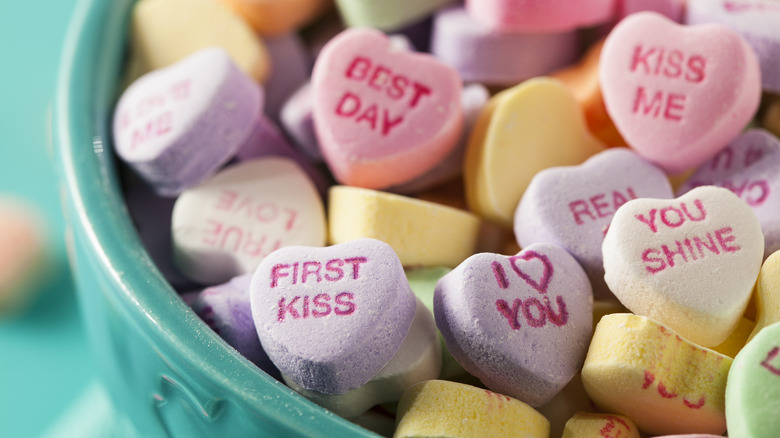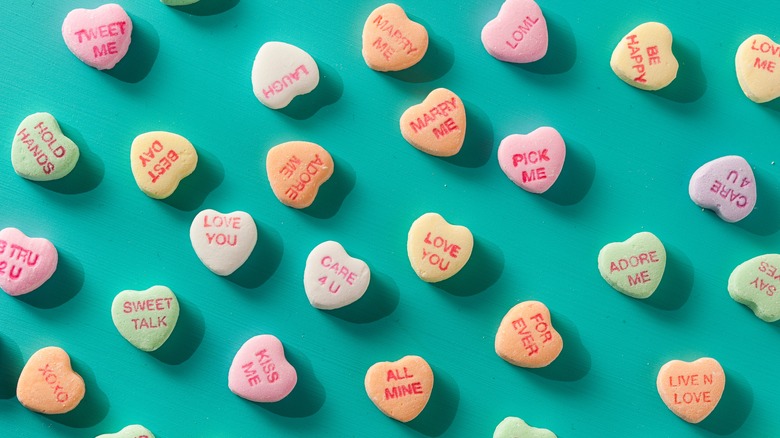The Little Known History Behind Valentine's Day Conversation Hearts
Love or hate them, there's no denying that Sweethearts conversation hearts are a Valentine's Day staple. In fact, in 2019, when the world went without the classic candy for the love-centered holiday, things just didn't quite feel the same. After all, what's Valentine's Day without a box of Sweethearts to decipher? Reading out "BE MINE" and "ONLY YOU" messages on those little chalky hearts brings out a delicious nostalgia that even the most romance-averse can indulge in.
But did you know that the history behind those little Sweethearts goes far deeper than just the bottom of that iconic cardboard box? The origins of conversation hearts lie at the heart of American confectionary history. The story starts in 1847 in Boston, Massachusetts when Oliver Chase invented a device to cut pressed lozenges. But he wasn't a candy maker by trade. Instead, he was a pharmacist looking to speed along his medicine-making process.
However, when those medicinal powders were switched out for sugar, the device became the first candy-making machine, churning out small, round sugar candies that would become the iconic Necco wafer. But it was Oliver's brother, Daniel, who invented the machine that would give the hearts their conversational quality by imprinting those wafer candies with messages using a red vegetable dye. It wasn't hearts that those messages were printed on, though — those would come after Oliver and Daniel Chase's company merged with several other candy companies in 1901.
From the medicine cabinet to holiday classic
Originally, the Chase brothers' company sold candy shells that featured messages written on paper and tucked inside. However, Daniel's stamp invention opened up a whole new world of candy possibilities. They started pressing other candies in various shapes, including baseballs, horseshoes, and yes, even hearts — though these were much larger than the little hearts we know and love today. Earlier hearts featured longer messages, such as "Married in white, you have chosen right," and were often served at weddings.
It wasn't until 1901 — when Necco was formed, thanks to a New England candy company merger — that conversation hearts became a cultural staple for over 100 years. They even made their way into the beloved "Anne of Green Gables" book series in 1908 when Anne received a candy heart saying, "You are sweet."
As the 20th century progressed, the candies became central to the aesthetic of Valentine's Day. The small cardboard box and the various pastel colors turned into a necessity for Valentine's celebrations — especially among school children — as the boxes were the perfect candy to pass around among friends. The messages could be used as conversation starters, to pass along inside jokes, or to slyly send hints to a classmate crush.
It wasn't until 1988, when Necco acquired the Stark Candy Company, that the conversation hearts took on the Sweethearts name that has since become synonymous with the love-centric holiday. But there have been many changes for the chalky little candy since then.
Keeping up with the times
Recent years haven't been so kind to those sugary hearts, or for the Necco company in general. In 2018, the company filed for Chapter 11 bankruptcy. Necco was first sold to Round Hill Investments the same year, and many candy lovers hoped that the company would help keep the Sweethearts candies afloat (along with the beloved Necco wafers). However, Necco's headquarters in Revere, Massachusetts shuttered for good in July of 2018, leaving the world without the candy hearts.
However, Necco was then sold to Spangler Candy Company — the company behind candies such as Dum Dum lollipops — and candy hearts made their comeback in 2020. But the reintroduction of Sweethearts didn't go off without a hitch, as many of the candy hearts were left without their signature messages. Luckily, this hitch was fixed in later rollouts of the candy.
It's not just the company behind the candy that has changed. The messages on those little hearts have also evolved with the times. Along with classic messages, the hearts have featured an evolving lineup of sweet sentiments with changing technology and communication practices. Messages such as "FAX ME" and "DIG ME," (which, admittedly, may have expired sooner than the candies themselves) have made their way to the candy box over the years. More recently, messages such as "TEXT ME" have been included in the hearts. And it looks like the candies will continue to evolve with the times, while also remaining a little piece of sweet nostalgia.


